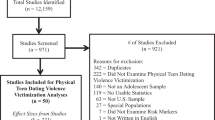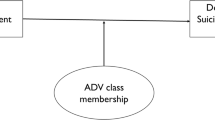Abstract
Purpose
Poor mental health is associated with teen dating violence (TDV), but whether there are specific types of psychiatric disorders that could be targeted with intervention to reduce TDV remains unknown.
Methods
Multivariable logistic regression models were used to assess the associations of psychiatric disorders that emerged prior to dating initiation with subsequent physical dating violence in a nationally representative sample from the National Comorbidity Survey Replication, adjusting statistically for adverse childhood experiences.
Results
In adjusted models, internalizing disorders (AOR 1.14, 95 % CI 1.04,1.25; no sex differences noted) and externalizing disorders (males: AOR 1.28, 95 % CI 1.10, 1.49; females: AOR 1.85, 95 % CI 1.55, 2.21) were associated with subsequent involvement in any physical dating violence victimization or perpetration before the age of 21. Those at greatest risk included girls with ADHD and a substance use disorder, in particular.
Conclusions
The range of psychiatric disorders associated with TDV is broader than has generally been recognized for both boys and girls. Clinical and public health prevention programs should incorporate strategies for addressing multiple pathways through which poor mental health may put adolescents at risk for TDV.

Similar content being viewed by others

References
Silverman JG, Raj A, Mucci LA, Hathaway JE (2001) Dating violence against adolescent girls and associated substance use, unhealthy weight control, sexual risk behavior, pregnancy, and suicidality. JAMA 286(5):572–579. doi:10.1001/jama.286.5.572
Vagi KJ, O’Malley Olsen E, Basile KC, Vivolo-Kantor AM. (2015) Teen dating violence (physical and sexual) among US High School students. JAMA Pediatrics. doi:10.1001/jamapediatrics.2014.3577 (epub ahead of print)
Halpern CT, Oslak SG, Young ML, Martin SL, Kupper LL (2001) Partner violence among adolescents in opposite-sex romantic relationships: findings from the National Longitudianl Study of adolescent health. Am J Public Health 91(10):1679–1685
Foshee VA, Linder F, MacDougall JE, Bengdiwala S (2001) Gender differences in the longitudinal predictors of adolescent dating violence. Prev Med 32(2):128–141. doi:10.1006/pmed.2000.0793
McCauley HL, Tancredi DJ, Silverman JG, Decker MR, Austin SB, McCormick MC, Virata MC, Miller E (2013) Gender-equitable attitudes, bystander behavior, and recent abuse perpetration against heterosexual dating partners of male high school athletes. Am J Public Health 103(10):1882–1887. doi:10.2105/AJPH.2013.301443
Callahan MR, Tolman RM, Saunders DG (2003) Adolescent dating violence victimization and psychological well-being. J Adolesc Res 18(6):664–681. doi:10.1177/0743558403254784
Turner HA, Finkelhor D, Shattuck A, Hamby S (2012) Recent victimization exposure and suicidal ideation in adolescents. Arch Pediatr Adolesc Med 166(12):1149–1154. doi:10.1001/archpediatrics.2012.1549
Vázquez F, Torres A, Otero P (2012) Gender-based violence and mental disorders in female college students. Soc Psychiatry Psychiatr Epidemiol 47(10):1657–1667. doi:10.1007/s00127-012-0472-2
Exner-Cortens D, Eckenrode J, Rothman E (2013) Longitudinal associations between teen dating violence victimization and adverse health outcomes. Pediatrics 131(1):71–78. doi:10.1542/peds.2012-1029
Burton CW, Halpern-Felsher B, Rehm RS, Rankin SH, Humphreys JC (2014) Depression and self-rated health among rural women who experienced adolescent dating abuse: a mixed methods study. J Interpers Violence (epub ahead of print)
Maas CD, Fleming CB, Herrenkohl TI, Catalano RF (2010) Childhood predictors of teen dating violence victimization. Violence Vict 25(2):131–149
Lehrer JA, Buka S, Gortmaker S, Shrier LA (2006) Depressive symptomatology as a predictor of exposure to intimate partner violence among US female adolescents and young adults. Arch Pediatr Adolesc Med 160:270–276. doi:10.1001/archpedi.160.3.270
Lormand DK, Markham CM, Perskin MF, Byrd TL, Addy RC, Baumler E, Tortolero SR (2013) Dating violence among urban, minority, middle school youth and associated sexual risk behaviors and substance use. J Sch Health 83(6):415–421. doi:10.1111/josh.12045
Temple JR, Shorey RC, Fite P, Stuart GL, Le VD (2013) Substance use as a longitudinal predictor of the perpetration of teen dating violence. J Youth Adolesc 42:596–606. doi:10.1007/s10964-012-9877-1
Miller E, Breslau J, Chung WJ, Green JG, McLaughlin KA, Kessler RC (2011) Adverse childhood experiences and risk of physical violence in adolescent dating relationships. J Epidemiol Community Health 65:1006–1013. doi:10.1136/jech.2009.105429
Green JG, McLaughlin KA, Berglund PA, Gruber MJ, Sampson NA, Zaslavsky AM, Kessler RC (2010) Childhood adversities and adult psychiatric disorders in the national comorbidity survey replication I: associations with first onset of DSM-IV disorders. Arch Gen Psychiatry 67(2):113–123. doi:10.1001/archgenpsychiatry.2009.186
Anda RF, Felitti VJ, Bremner JD, Walker JD, Whitfield C, Perry BD, Dube SR, Giles WH (2006) The enduring effects of abuse and related adverse experiences in childhood: a convergence of evidence from neurobiology and epidemiology. Eur Arch Psychiatry Clin Neurosci 256:174–186
Swahn MH, Bossarte RM, Sullivent EE (2008) Age of alcohol use initiation, suicidal behavior, and peer and dating violence victimization and perpetration among high-risk, seventh grade adolescents. Pediatrics 121(2):297–305. doi:10.1542/peds.2006-2348
Kessler RC, Berglund P, Chiu WT, Demler O, Heeringa S, Hiripi E, Jin R, Pennell BE, Walters EE, Zaslavsky A, Zheng H (2004) The US National Comorbidity Survey replication (NCS-R): design and field procedures. Int J Methods Psychiatric Res 13(2):69–92
Kessler RC, Merikangas KR (2004) The National Comorbidity Survey Replication (NCS-R): background and aims. Int Methods Psychiatric Res 13:60–68
Straus MA, Hamby S, Boney-McCoy S, Sugarman DB (1996) The Revised Conflict Tactics Scale (CTS2): development and preliminary psychometric data. J Fam Issues 17:283–316. doi:10.1177/019251396017003001
World Health Organization (1991) International classification of diseases (ICD-10). Switzerland, Geneva
APA (1994) Diagnostic and statistical manual of mental disorders. Washington, D.C.
Keyes KM, Eaton NR, Krueger RF, McLaughlin KA, Wall MM, Grant BF, Hasin DS (2012) Childhood maltreatment and the structure of common psychiatric disorders. Br J Psychiatry 200(2):107–115
Verona E, Javdani S, Sprague J (2011) Comparing factor structures of adolescent psychopathology. Psychol Assess 23(2):545–551. doi:10.1037/a0022055
Kessler RC, Ormel J, Petukhova M, McLaughlin KA, Green JG, Russo LJ et al (2011) Development of lifetime comorbidity in the world health organization world mental health surveys. Arch Gen Psychiatry 68(1):90–100. doi:10.1001/archgenpsychiatry.2010.180
Kessler RC, Ustun TB (2004) The World Mental Health (WMH) Survey Initiative version of the World Health Organization (WHO) composite international diagnostic interview (CIDI). Int Methods Psychiatric Res 13:93–121
Kessler RC, Amminger GP, Aguilar-Gaxiola S, Alonso J, Lee S, Ustün TB (2007) Age of onset of mental disorders: a review of recent literature. Curr Opin Psychiatry 20(4):359–364
Knäuper B, Cannell CF, Schwarz N, Bruce ML, Kessler RC (1999) Improving accuracy of major depression age-of-onset reports in the US National Comorbidity Survey. Int J Methods Psychiatric Res 8(1):39–48. doi:10.1002/mpr.55
Kendler KS, Silberg JL, Neale MC, Kessler RC, Heath AC, Eaves LJ (1991) The family history method: whose psychiatric history is measures? Am J Psychiatry 148:1501–1504
Andreasen NC, Endicott J, Spitzer RL, Winokur G (1977) The family history method using diagnostic criteria. Reliability and validity. Arch Gen Psychiatry 34:1229–1235
RTI (2002) Software for Survey Data Analysis (SUDAAN), version 8.1. Research Triangle Institute: Research Triangle Park, NC
Kessler RC, Chiu WT, Demler O, Merikangas KR, Walters EE (2005) Prevalence, severity, and comorbidity of twelve-month DSM-IV disorders in the National Comorbidity Survey Replication (NCS-R). Arch Gen Psychiatry 62(6):617–627. doi:10.1001/archpsyc.62.6.617
Wymbs BT, Molina B, Pelham W, Cheong J, Gnagy E, Belendiuk K, Walther C, Babinski D, Waschbusch D (2012) Risk of intimate partner violence among young adult males with childhood ADHD. J Atten Disord 16(5):373–383. doi:10.1177/1087054710389987
Brook DW, Brook JS, Rubenstone E, Zhang C, Saar NS (2011) Developmental associations between externalizing behaviors, peer delinquency, drug use, perceived neighborhood crime, and violence behavior in urban communities. Aggress Behav 37(4):349–361. doi:10.1002/ab.20397
Arseneault L, Moffitt TE, Caspi A, Taylor PJ, Silva PA (2000) Mental disorders and violence in a total birth cohort: results from the dunedin study. Arch Gen Psychiatry 57(10):979–986. doi:10.1001/archpsyc.57.10.979
Kann RT, Hann FJ (2000) Disruptive behavior disorders in children and adolescents: how do girls differ from boys? J Couns Dev 78(3):267–274. doi:10.1002/j.1556-6676.2000.tb01907.x
Riehman KS, Bluthenthal R, Juvonen J, Morral A (2003) Adolescent social relationships and the treatment process: findings from quantitative and qualitative analyses. J Drug Issues 33(4):865–896. doi:10.1177/002204260303300405
Vanoss Marín B, Coyle KK, Gómez CA, Carvajal SC, Kirby DB (2000) Older boyfriends and girlfriends increase risk of sexual initiation in young adolescents. J Adolesc Health 27(6):409–418. doi:10.1016/S1054-139X(00)00097-5
Gowen LK, Feltman SS, Diaz R, Yisrael DS (2004) A comparison of the sexual behaviors and attitudes of adolescent girls with older Vs. similar-aged boyfriends. J Youth Adolesc 33(2):167–175. doi:10.1023/B:JOYO.0000013428.41781.a0
Alden LE, Taylor CT (2004) Interpersonal processes in social phobia. Clin Psychol Rev 24(7):857–882. doi:10.1016/j.cpr.2004.07.006
Keenan-Miller D, Hammen C, Brennan P (2007) Adolescent psychosocial risk factors for severe intimate partner violence in young adulthood. J Consult Clin Psychol 75(3):456–463. doi:10.1037/0022-006X.75.3.456
Foshee VA, Benefield TS, Ennett ST, Bauman KE, Suchindran C (2004) Longitudinal predictors of serious physical and sexual dating violence victimization during adolescence. Prev Med 39(5):1007–1016. doi:10.1016/j.ypmed.2004.04.014
Kessler RC, Berglund P, Demier O, Merikangas KR, Walters EE (2005) Lifetime prevalence and age-of-onset distributions of DSM-IV disorders in the national comorbidity survey replication. Arch Gen Psychiatry 62:593–602. doi:10.1001/archpsyc.62.6.593
Cottler LB (2007) Drug use disorders in the national comorbidity survey: have we come a long way? JAMA Psychiatry 64(3):380–381
Degenhardt L, Bohnert KM, Anthony JC (2008) Assessment of cocaine and other drug dependence in the general population: “Gated” versus “ungated” approaches. Drug Alcohol Depend 93(3):227–232
Ellsberg M, Jansen HA, Heise L, Watts CH, Garcia-Moreno C et al (2008) Intimate partner violence and women’s physical and mental health in the WHO multi-country study on women’s health and domestic violence: an observational study. Lancet 371(9619):1165–1172
Acknowledgments
This work was supported by NIH/ORWH Building Interdisciplinary Research Careers in Women’s Health (BIRCWH) K12HD043441 scholar funds to McCauley.
Conflicts of interest
On behalf of all authors, the corresponding author states that there is no conflict of interest.
Author information
Authors and Affiliations
Corresponding author
Rights and permissions
About this article
Cite this article
McCauley, H.L., Breslau, J.A., Saito, N. et al. Psychiatric disorders prior to dating initiation and physical dating violence before age 21: findings from the National Comorbidity Survey Replication (NCS-R). Soc Psychiatry Psychiatr Epidemiol 50, 1357–1365 (2015). https://doi.org/10.1007/s00127-015-1044-z
Received:
Accepted:
Published:
Issue Date:
DOI: https://doi.org/10.1007/s00127-015-1044-z



